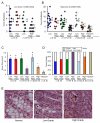A gnotobiotic mouse model demonstrates that dietary fiber protects against colorectal tumorigenesis in a microbiota- and butyrate-dependent manner
- PMID: 25266735
- PMCID: PMC4258155
- DOI: 10.1158/2159-8290.CD-14-0501
A gnotobiotic mouse model demonstrates that dietary fiber protects against colorectal tumorigenesis in a microbiota- and butyrate-dependent manner
Abstract
Whether dietary fiber protects against colorectal cancer is controversial because of conflicting results from human epidemiologic studies. However, these studies and mouse models of colorectal cancer have not controlled the composition of gut microbiota, which ferment fiber into short-chain fatty acids such as butyrate. Butyrate is noteworthy because it has energetic and epigenetic functions in colonocytes and tumor-suppressive properties in colorectal cancer cell lines. We used gnotobiotic mouse models colonized with wild-type or mutant strains of a butyrate-producing bacterium to demonstrate that fiber does have a potent tumor-suppressive effect but in a microbiota- and butyrate-dependent manner. Furthermore, due to the Warburg effect, butyrate was metabolized less in tumors where it accumulated and functioned as a histone deacetylase (HDAC) inhibitor to stimulate histone acetylation and affect apoptosis and cell proliferation. To support the relevance of this mechanism in human cancer, we demonstrate that butyrate and histone-acetylation levels are elevated in colorectal adenocarcinomas compared with normal colonic tissues.
Significance: These results, which link diet and microbiota to a tumor-suppressive metabolite, provide insight into conflicting epidemiologic findings and suggest that probiotic/prebiotic strategies can modulate an endogenous HDAC inhibitor for anticancer chemoprevention without the adverse effects associated with synthetic HDAC inhibitors used in chemotherapy.
©2014 American Association for Cancer Research.
Figures




Comment in
-
Untangling the fiber yarn: butyrate feeds Warburg to suppress colorectal cancer.Cancer Discov. 2014 Dec;4(12):1368-70. doi: 10.1158/2159-8290.CD-14-1231. Cancer Discov. 2014. PMID: 25477104 Free PMC article.
Similar articles
-
Untangling the fiber yarn: butyrate feeds Warburg to suppress colorectal cancer.Cancer Discov. 2014 Dec;4(12):1368-70. doi: 10.1158/2159-8290.CD-14-1231. Cancer Discov. 2014. PMID: 25477104 Free PMC article.
-
The microbiome and its potential as a cancer preventive intervention.Semin Oncol. 2016 Feb;43(1):97-106. doi: 10.1053/j.seminoncol.2015.09.001. Epub 2015 Sep 8. Semin Oncol. 2016. PMID: 26970128 Free PMC article. Review.
-
Butyrate production from high-fiber diet protects against lymphoma tumor.Leuk Lymphoma. 2016 Oct;57(10):2401-8. doi: 10.3109/10428194.2016.1144879. Epub 2016 Feb 17. Leuk Lymphoma. 2016. PMID: 26885564
-
Importance of the Microbiota Inhibitory Mechanism on the Warburg Effect in Colorectal Cancer Cells.J Gastrointest Cancer. 2020 Sep;51(3):738-747. doi: 10.1007/s12029-019-00329-3. J Gastrointest Cancer. 2020. PMID: 31735976 Review.
-
Molecular pathways: gene-environment interactions regulating dietary fiber induction of proliferation and apoptosis via butyrate for cancer prevention.Clin Cancer Res. 2014 Feb 15;20(4):799-803. doi: 10.1158/1078-0432.CCR-13-2483. Epub 2013 Nov 22. Clin Cancer Res. 2014. PMID: 24270685 Free PMC article.
Cited by
-
Reinventing gut health: leveraging dietary bioactive compounds for the prevention and treatment of diseases.Front Nutr. 2024 Oct 22;11:1491821. doi: 10.3389/fnut.2024.1491821. eCollection 2024. Front Nutr. 2024. PMID: 39502877 Free PMC article. Review.
-
Genetics, diet, microbiota, and metabolome: partners in crime for colon carcinogenesis.Clin Exp Med. 2024 Oct 29;24(1):248. doi: 10.1007/s10238-024-01505-x. Clin Exp Med. 2024. PMID: 39470880 Free PMC article. Review.
-
The gut microbiome and dietary fibres: implications in obesity, cardiometabolic diseases and cancer.Nat Rev Microbiol. 2024 Oct 10. doi: 10.1038/s41579-024-01108-z. Online ahead of print. Nat Rev Microbiol. 2024. PMID: 39390291 Review.
-
Metabolic mediators: microbial-derived metabolites as key regulators of anti-tumor immunity, immunotherapy, and chemotherapy.Front Immunol. 2024 Sep 16;15:1456030. doi: 10.3389/fimmu.2024.1456030. eCollection 2024. Front Immunol. 2024. PMID: 39351241 Free PMC article. Review.
-
Adherence to the Mediterranean Diet and Colorectal Cancer Risk Among Moroccan Population: Hospital-Based Case Control Study.Asian Pac J Cancer Prev. 2024 Aug 1;25(8):2853-2860. doi: 10.31557/APJCP.2024.25.8.2853. Asian Pac J Cancer Prev. 2024. PMID: 39205583 Free PMC article.
References
-
- Bingham SA, Day NE, Luben R, Ferrari P, Slimani N, et al. Dietary fibre in food and protection against colorectal cancer in the European Prospective Investigation into Cancer and Nutrition (EPIC): an observational study. Lancet. 2003;361:1496–501. - PubMed
-
- Fuchs CS, Giovannucci EL, Colditz GA, Hunter DJ, Stampfer MJ, Rosner B, et al. Dietary fiber and the risk of colorectal cancer and adenoma in women. The New England Journal of Medicine. 1999;340:169–76. - PubMed
-
- Park Y, Hunter DJ, Spiegelman D, Bergkvist L, Berrino F, van den Brandt PA, et al. Dietary fiber intake and risk of colorectal cancer: a pooled analysis of prospective cohort studies. The Journal of the American Medical Association. 2005;294:2849–57. - PubMed
-
- Schatzkin A, Mouw T, Park Y, Subar AF, Kipnis V, Hollenbeck A, et al. Dietary fiber and whole-grain consumption in relation to colorectal cancer in the NIH-AARP Diet and Health Study. The American Journal of Clinical Nutrition. 2007;85:1353–60. - PubMed
Publication types
MeSH terms
Substances
Grants and funding
LinkOut - more resources
Full Text Sources
Other Literature Sources
Medical
Molecular Biology Databases

